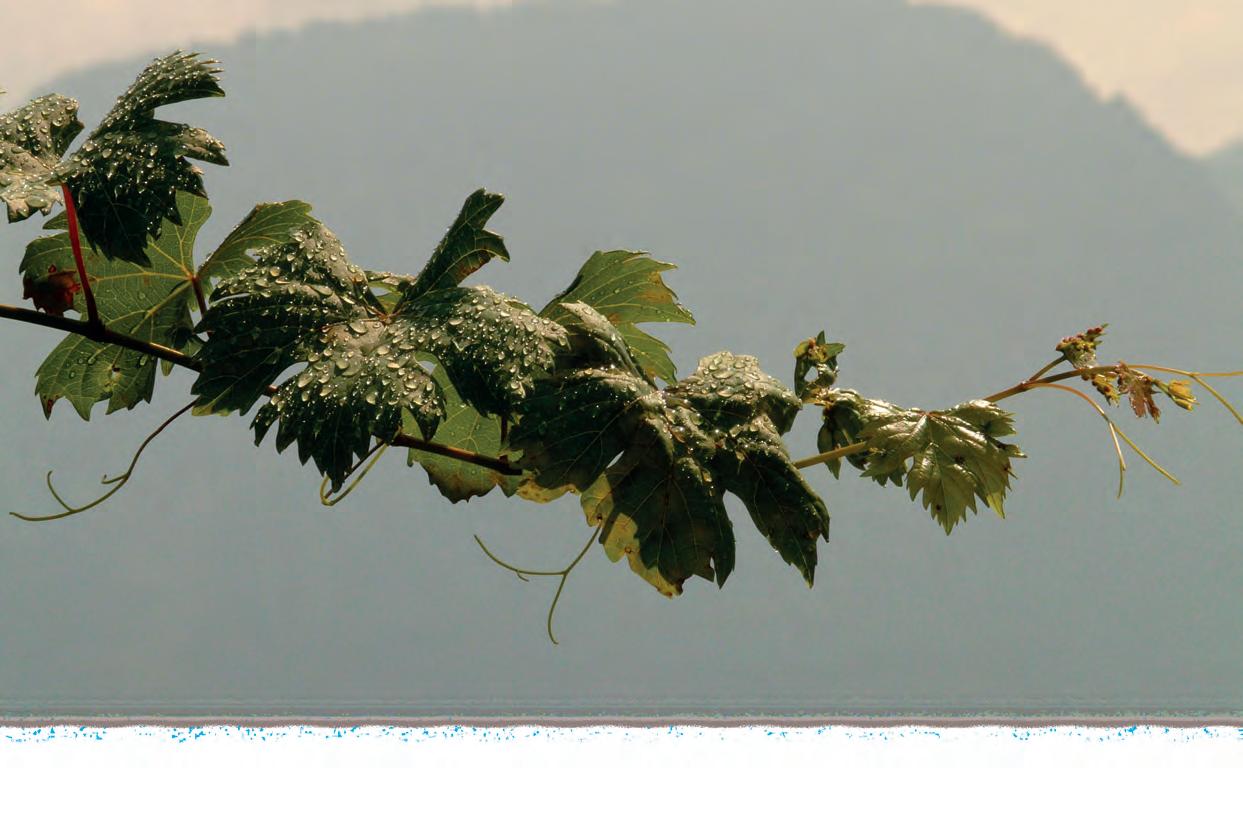
11 minute read
Snapshot of Californian Pinot Noir
BY: NINA JENSEN
A tasting of a broad spectrum of Californian Pinot Noirs gave rise to this article sponsored by Wines of California.

In the vast tapestry of California viticultural landscape, one grape varietal stands out as a true enigma: Pinot Noir. Sensitive to the winemaker’s touch and with a high degree of terroir-transparency, California’s diverse microclimates and varied geography provide an ideal canvas for the frickle Pinot Noir to express its full potential. Cultivated along the entire coastline from the growing Mendocino to the complex Sonoma, across the overlooked Monterrey and all the way to the extremes of Santa Rita Hills and beyond. Pinot Noir has enchanted the world and taken a stronghold in California, both when it comes to domestic consumption as well as fine wine export. This article gives a small glimpse into the diversity of Californian Pinot Noir through 12 examples tasted.
Clone Wars
With the rise of Pinot in California came the rise- and talk of clones. The illicitly imported Pinot Noir grapevine cuttings were field selections but eventually became the so-called “heritage clones” including Martini, Wente, Mount Eden, Swan, Calera, and Hanzell and noncertified “clones” known in the vernacular as David Bruce, Chalone and Pisoni in California. The smugglers were reluctant to admit their transgressions so the lineage of these selections in most cases remains a mystery. By the mid-1990s, the French threatened legal action against any Americans that used grapevine cuttings from their famous vineyards especially if their source was expressively promoted. Nonetheless several wineries today provide precise information on what clones they use, some even on the bottle. Dijon clones have for the longest time been all the craze, but many are curious to see if that continues as California faces increasing challenges with drought (as well as forest fires).
SONOMA: FROM COAST TO VALLEY
The first county that usually comes to mind whenever we think of Cali Pinot is the great Sonoma.

Sonoma is one of the most diversified regions in California: Shaped by the cool of the Pacific, the submersion under water, a ripple of mountain ranges and the valleys between them created by the North American Plate and the Pacific Plate. Among winemakers of Sonoma, it is said that Sonoma has more soil types than entire France. Sonoma soils generally reflect the marine history—a result of the land’s long submersion beneath the Pacific—and volcanic matter, coming from tectonic activity and eruptions. Overall, the land is more granitic to the west of the San Andreas Fault and more diverse to the east. On a Winkler scale the county spans from I in the western part to III in the northeastern AVA of Alexander Valley, anything from Cabernet Sauvignon to Pinot Noir can thrive here. While Sonoma Pinto occupy a much larger space in the mind of a sommelier and on the wine lists around, it is only very recently it has overtaken Cabernet Sauvignon as the most planted varietal. The range of Pinot is wide, from the cool, light, low ABV kinds from Western Sonoma Coast or around Pataluma gap to the opulent, rich and darker 14-15% from the warm parts of Russian River Valley. You could consider the evolution of Pinot Noir in Sonoma in three stages from the early initiators with Hanzell, Joe Swan and Rochioli in the front to the next wave with the likes of Ted Lemon at Littorai, Williams-Selyem and Hirsch to the current stage led by producers such as Raen, Red Car and Failla catalyzed by the IPOB movement where many follow the second-wave-suit searching for the elegant expression. Each of the five samples sent were on a different part of the spectrum with Sonoma Coast Vineyards and Joseph Swan in the elegant, Burgundian and the Marimar, Larue and Twomey more evidently Californian.
2016 Sonoma Coast
Pinot Noir, Larue: Sweet fruitcondition, baked clay quality, lifted acidity and crushed violets. Cherry and wild strawberry takes the center stage, starting out with tartness in the fruit transforming to a more sweet-toned aftertaste. A little evolution showing earthiness. General straight forward and pleasant style.
2018 Freestone Hills Pinot Noir Sonoma Coast, Sonoma Coast
Vineyards:
Dijon Clones 115, 667, 777. A very Burgundian nose with dried spices, savory undertones, prominent earthiness of freshly tilled earth and a tart, refined fruit condition. A focused acidity and slightly more grippy tannins that are harmonized by the red fruits.
2018 Mas Cavalls Doña
Margarita Vineyard, Sonoma Coast, Marimar Estate: Soft, velvet texture, red- and blue fruit dominant in a shyer aromatic profile. Ripe fruitcondition, a hint of savory tones and mellow acidity. Needs some air to open up after which is reveals more vibrancy and brightness but still with a core of ripe red fruit.
2020 Russian River
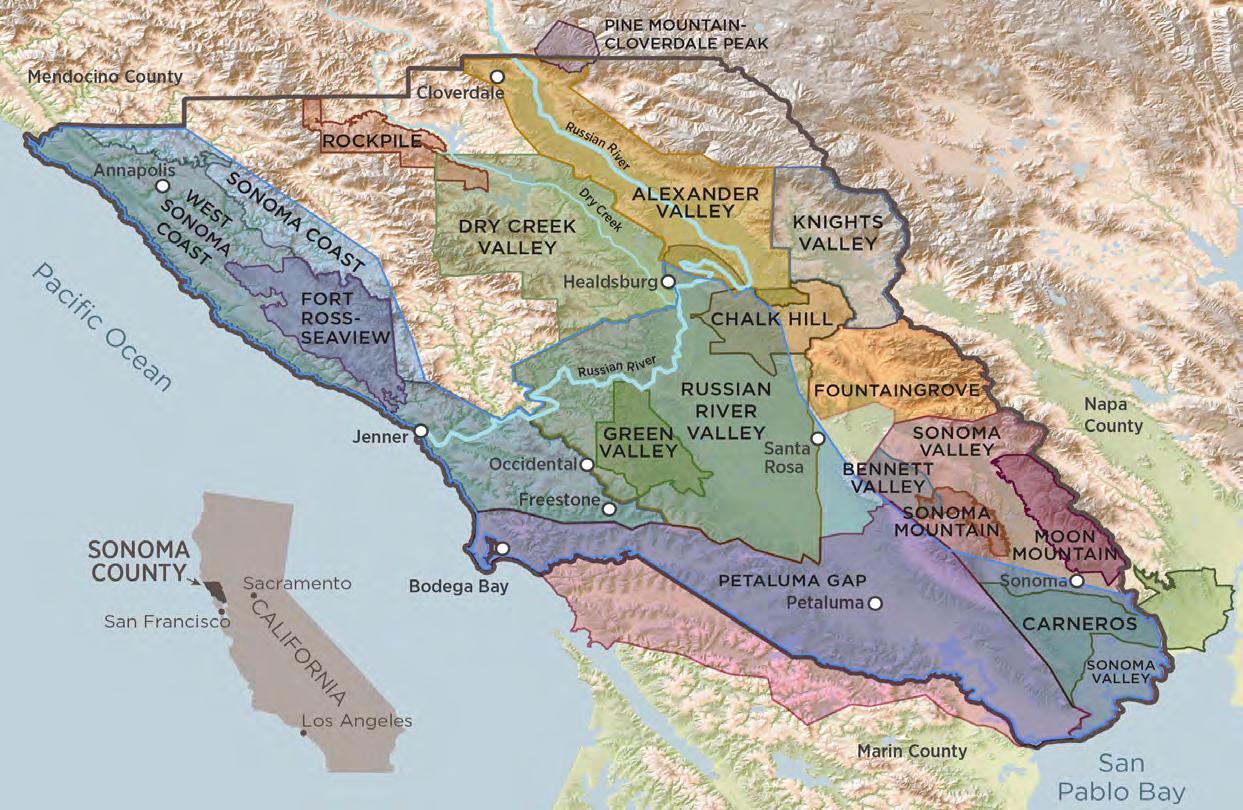
Pinot Noir, Twomey: Dominated by sweet oak spiced, voluminous red fruit with a creamy texture and soft tannins. Blueberry-yoghurt, amarena cherry and warm raspberry. The alcohol leaves a warming sensation. A broad, polished and textbook example of Russian River.
2016 Trenton Estate Vineyard Russian River Valley, Joseph Swan Vineyards: All the different Dijon clones. Supremely fragrant and aromatic. Light, crunchy with an alluring intensity that doesn’t immediately reveal itself. Clear, asphalt minerality, super tart fruit with redcurrant, underripe strawberry, red apple, cranberry, dried orange and grapefruit, sour cherry plus an enchanting, lifted rose-like florality. A juicy finish. Marked tannins in perfect harmony with the fruit intensity that turns slightly riper in the aftertaste. So pure and precise with jus 12,2%. Despite Joes passing in 1989 The icon lives on.
CARNEROS: CROSSROAD BETWEEN NAPA AND SONOMA
Renowned for its cool maritime climate influenced by San Pablo Bay, the foggy mornings, and clayey soils, Carneros is the ideal homeplace for Pinot and Chardonnay both in still and sparkling version, the latter notably made famous by the Taittinger, Freixenet and Cordoníu establishments in the AVA. Falling into the pathway of the Petaluma Gap, the diurnal swings are enhanced, and while warm at noon, the average temperatures are some of the lowest in both Napa and Sonoma County. Carneros Chardonnay and Pinot Noir are typically vinified in a style somewhere in between that of the Russian River Valley and the Sonoma Coast. While 2/3 of the vineyards are in Sonoma,
MONTEREY: DRAMATIC CHANGES
South of the San Francisco Bay is Monterey County. In the wake of Napa’s success, the Monterey AVA, was extensively planted with vines. Monterey AVA largely became source to satisfy the demand for cheap table wines, but it holds a far greater potential for quality wines, boasting one of the longest growing seasons in California. Most of Monterey’s production is centered in- and around Salinas Valley which runs northsouth starting by Monterey Bay in the north. In the southern end, there is a gap in the mountains that runs perpendicular to the coast (west to east) allow- most of the bench-mark wineries are in Napa Valley. The main soil type of the region is called Haire Coombs and is named from the Coombs soil series that runs throughout most of the AVA: A gravelly bed overlayed by clay. One of the wines tasted realized the potential for cool, fresh wines while the other went in a much riper direction. Relative to its growing size of almost 4200ha, Carneros doesn’t appear too frequently on the labels, partly because the Sonoma section can also be labelled as the more popular Sonoma Valley or Petaluma Gap.
2019 Reserve Carneros Pinot Noir, Carneros Creek: Tart fruit with cherry pips, sour plum, fresh raspberry. Herbal, slightly green tannins, cedarwood, green tobacco, oolong tea. A lean and focused style.
2018 Estate Pinot Noir, Domaine Carneros: ing warm air at the southwestern end of the valley to pull in the cool ocean air downstream. While the cooling breezes from the north strongly regulate the temperature, they can’t maintain the cool temperature as they blow through the hot valley, meaning there is a dramatic temperature difference between the northern parts of the valley and the south. Apart from the strong winds there are two other factors at play as well: A fog running throughout the northern half of the valley and the altitude that some of the sub AVAs offer.
Sweet oak spices, sweet lacquorice, bakingspices and ripe blueberries. Soft acidity and gentle tannins.
The two examples tasted were from Arroyo Seco and Santa Lu- cia Highlands. The Arroyo Seco AVA, which translates to “dry riverbed,” starts in the west a steep, narrow gorge at the foot of the Santa Lucia Mountain range and extends east into a widening topography that eventually opens to the warm, fertile soil of the Salinas Valley. Exposed directly to the winds of the Pacific, the eastern end of Arroyo is significantly cooler than the more sheltered western portion. The loamy soils and varied sheltering from the winds allows for varietals as diversified as Riesling, Zinfandel, Rhône and Bordeaux varietals to be cultivated but Pinot Noir is a rare sight.

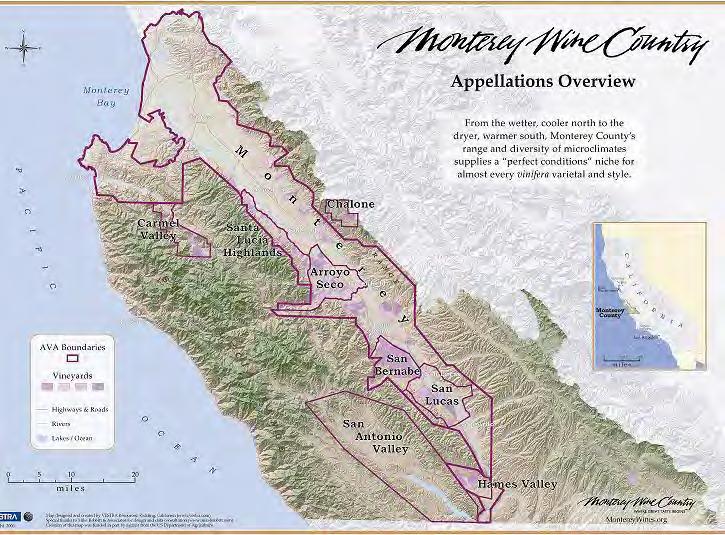
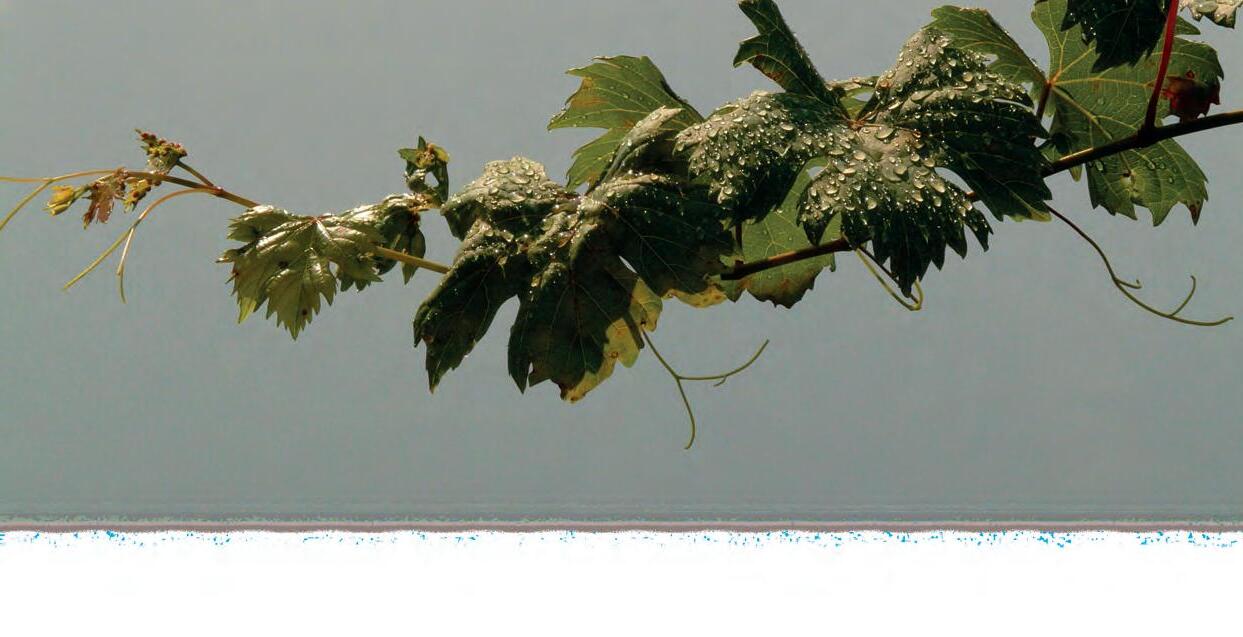
Arroyo Seco Up Close
(1) The "Gorge" - this narrow ravine is protected from the direct marine-influences of the Pacific Ocean. That said, fog from the Pacific Ocean does penetrate the landscape and further the terrain is hampered by a strong easterly wind. Due to the dramatic rise of the mountains as well as millenniums of erosion, the soil is very shallow with a thin, rocky (shale-based) layer of topsoil. Furthermore, there is only little flat, easily farm-able acreage and thus the steep terrain of the Santa Lucia Mountains constitutes the foundation of the plantings. This portion of the AVA accounts for the area's highest elevations.
(2) The "Ancient Riverbed"following the seasonal creek, this fanned landscape is bifurcated by benches (which the waterway cut) on either side as it heads towards the northern boundary of the AVA. Further, this section of terrain is directly exposed to the strong maritime influences. This portion experiences dense fogs and howling winds. It is further distinguished by meager soil conditions; river rocks litter the sandy surface-soil while dense, hardpan lens rests just feet below ground and promote root stress.
(3) The "Western Bench" - This portion is visually defined by a 40-foot palisade that rises vertically from the "Ancient Riverbed" section on the western, mountainside of the AVA. Adjacent to the Santa Lucia Highlands AVA and overlooking the riverbed, the bench experiences the extreme maritime influences. Fog saturates the landscape during the summer throughout the ripening months and galeforce winds rack vineyard sites. Additionally, the western bench feature hillside like conditions whereby roots struggle to find water and thus further limit tonnage yields.
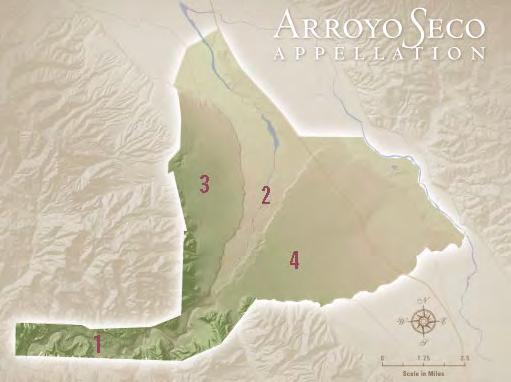
(4) The "Southern Benchland" - the bench and terrain located on the southern side of the riverbed which extends out south and east to the boarder of the appellation. This landscape features somewhat more fertile soil, yet it is counteracted by strong, easternly winds from the Gorge combining with the Pacific winds. Shale and Granite can be found in the topsoil here.
SANTA LUCIA HIGHLANDS: CENTER FOR PINOT
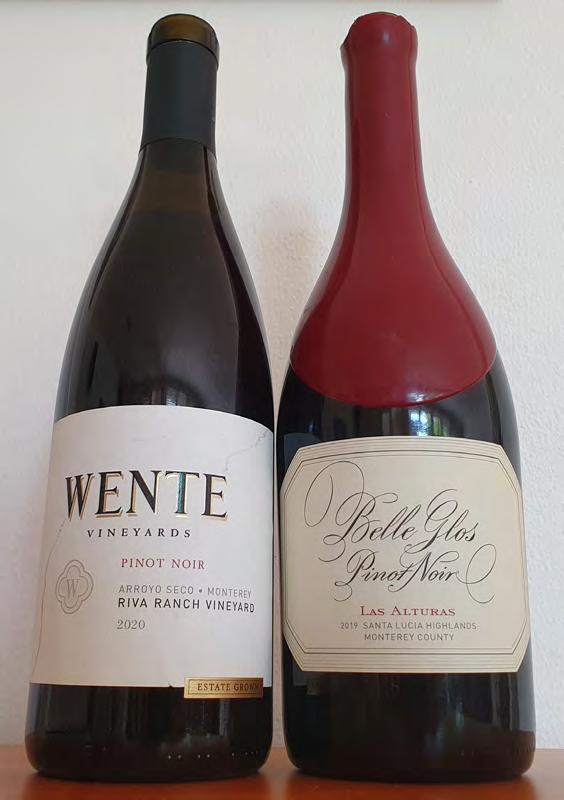
The Santa Lucia Highlands AVA is rather large with 1900ha of vines planted high up on southeast-facing terraces of the Santa Lucia Mountain range overlooking the Salinas River Valley with altitudes kissing 400m above sealevel.
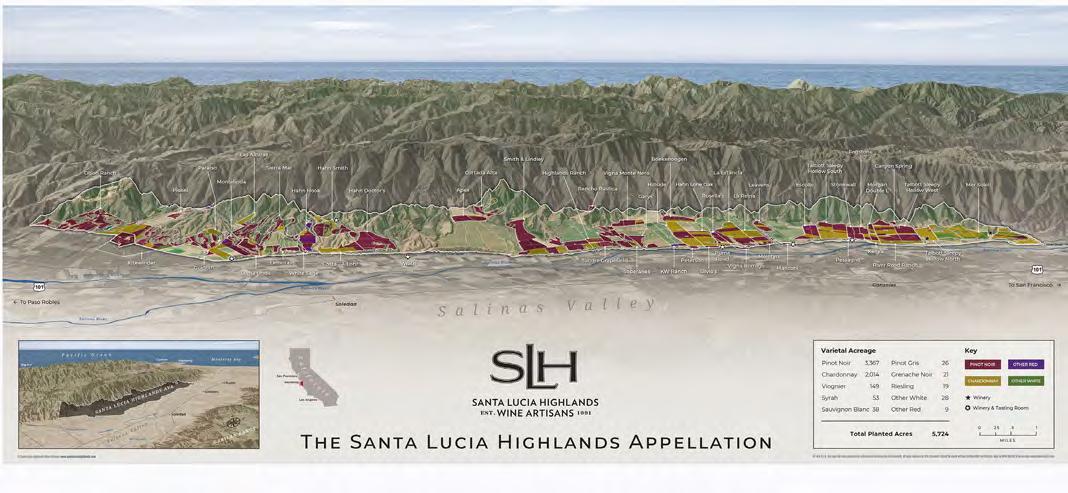
Within Monterey, that is otherwise planted to 40% Chardonnay, Santa Lucia Highlands is the most prominent place for cultivation of Pinot Noir. As one of the northernmost AVAs of Monterey, the conditions are almost a crossover between Burgundy and Rhône Valley with temperatures comparable to Burgundy but a constant afternoon wind so strong, that it influences the physiology of the grapes generating thicker skins which they need the abundant sunshine to fully mature.
The elevated position exposes vines to morning sunshine and afternoon maritime winds moderating the photosynthesis. Ultimately, this climate results in a long growing season, typically starting with budbreak in February or March but finishing the slow maturation with a harvest in September or October, enabling a strong varietal expression. The Altura vineyard featured here in the tasting is one of the highest vineyards of the region, located in the southern part of Santa Lucia Highlands. The color density surely carried the witness of the thick skins, but this example is also strikingly much a winemaking style, perhaps not giving the clearest representation of the region.
SANTA MARIA VALLEY & SANTA RITA HILLS
The last of the lineup both originated from Santa Barbara County. A county initiating the cultivation of Pinot Noir and Chardonnay early earn with the likes of Richard Sanford, Adam Tolmach, Jim Clendenen (Au Bon Climat) seeking out the elegance and potential of a place were long sunlight hours met with the cool influences of the Pacific. It is the longest transverse valley (East to West) found on the western Pacific coastn– from Alaska to South America. Much like the other regions covered here, Santa Barbara wine county is under the influence of the Pacific winds and the cool of the California Current. The soil here is complex with patchworks of limestone, sand, clay and loam and altitudes vary between 60meters up to 1000 meters with the lower areas being most windblown, offering a range of possibilities for the winemakers. With ‘Sideways’ the attention to Pinot Noir and Chardonnay was ignited on a commercial scale and since then both the broader AVA and its subs have blossomed. The samples provided were from Santa Maria Valley and Sta. Rita Hills. The climate is very dry throughout Santa Barbara and strongly influenced by cool Pacific Winds as the California Current passes right by. Both regions arguably have the longest growing season of entire California lasting for up to 160 days for dry wines. The long growing season starts with a mild, early spring followed by sunny, but cool summers with a few heat spikes mended by cool nights and morning fog. With 600 sunlight hours more throughout the growing season than Burgundy, it is remarkable to notice how vibrant, crisp and fresh the wines can be, thanks to the dynamics between the sun, wind, fog and steep hillsides.

As the first AVA-recipient in Central Coast, Santa Maria Valley is the senior of the two AVAs and the first region to plant Chardonnay and Pinot Noir. The most revered vineyards of the region are Bien Nacido and Sanford & Benedict, where rows on each of them are leased to multiple different producers.
In recent years, Santa Maria Valley has managed to establish itself as the new hotspot for wine tourism, giving the luxurious Napa Valley a run for its money with a friendly more casual vibe, boutique wineries and great variation in wines.

Sta. Rita Hills AVA was approved as recently as 2001 and constitutes a strip of land about 10 miles long. The weather is dry thanks to a serious rain shadow effect from the Purisima Hills (the northern boundary of the AVA) and the Sta. Rita Hills (on the south border. It is so dry that irrigation must be implemented to farm anything at all. The altitude span of Sta. Rita Hills is less wide than in Santa Barbara valley and seldomly higher 250m and with the lion’s share of the vineyards located around 100m above sea level. Throughout the AVA the temperature changes dramatically rapid becoming warmer as you move inland.
Enjoying a strong momentum throughout the past 5 years or so, the region, led by Rajat Parr and Sashi Morman, has gained presence globally on the top restaurants of the world, manifesting itself as an AVA of quality – impressive with an acreage of just 1092 hectares divided into 59 large vineyard sites. Looking at the consumer understanding of the wines, it surely is one of the places in California, where single vineyard wines have their strongest presence and is used on a broader scale: There is sort of a Burgundian mindset there in that respect, and for years there has been easily accessible resources of detailed outlays of the AVA and its vineyards. The tension, minerality and drive found in both Chardonnays and Pinot Noirs from Santa Rita Hills is often worth seeking out.
2019 Dierberg Vineyard Pinot
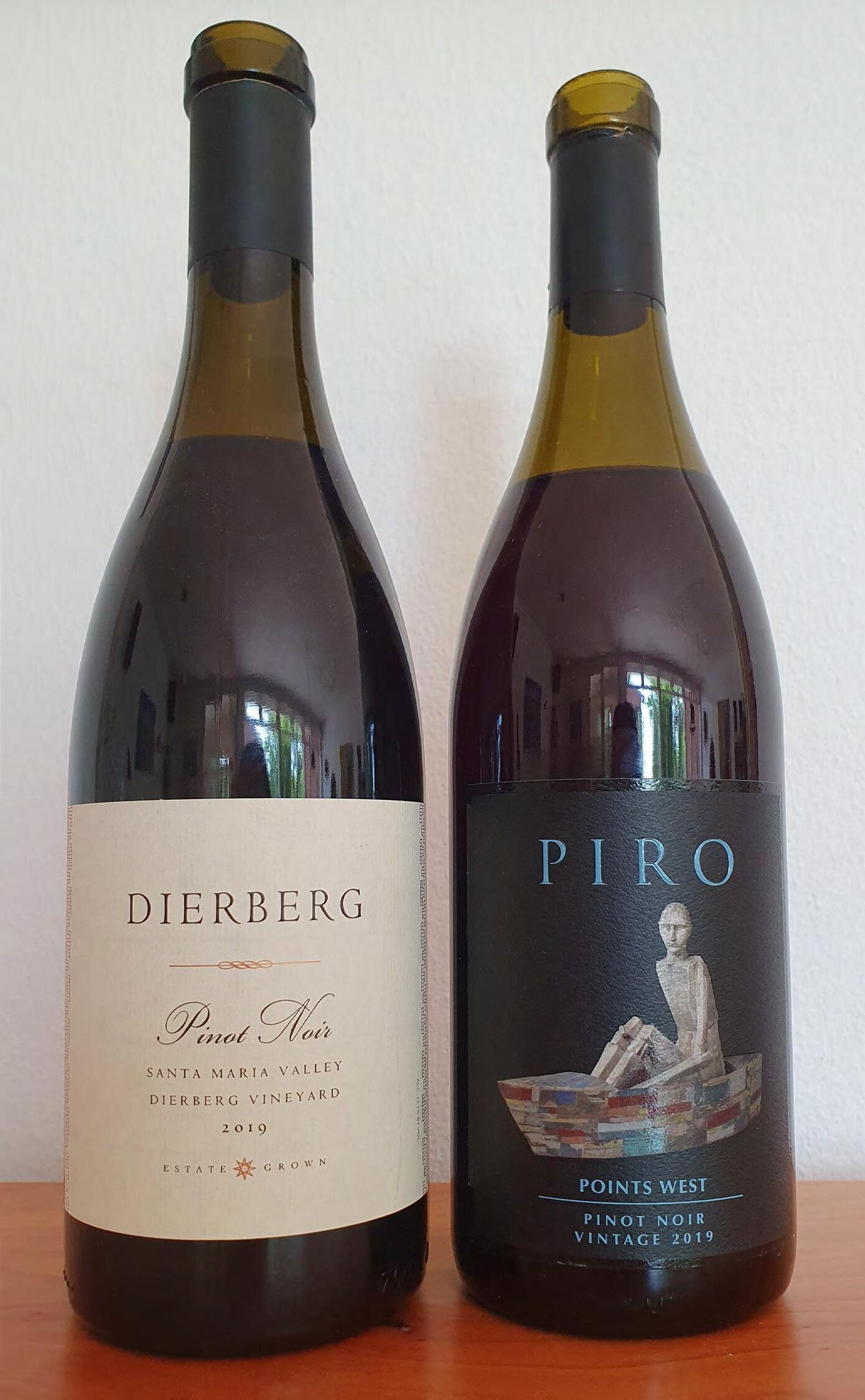
Noir Santa Maria Valley, Dierberg: It has that striking sweetand-sour balance. Almost like a sour candy where you have the tartness wrapping in a sweeter core. Lifted, angular acidity, ripe cranberry, wild strawberry, crushed violets, star anis, hint of earthiness and clove which brings some sophistication. A subtle hint of briny saltiness. Just-ripe tannins.
2019 Points West Pinot Noir, Sta. Rita Hills & Santa Maria Valley, Piro Wine Company: From grapes grown at Presqu’ile & Sanford & Benedict Vineyard. Less tension than the Dierberg Vineyard. Soft tannins, fairly fresh acidity, but the fruit dominates the palette. A classic fresh raspberry-blueberry-strawberry combo. Wellproduced textbook wine.










